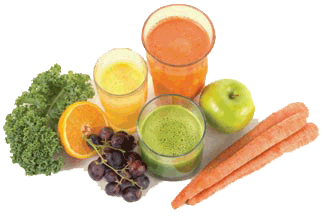Juicing for health
by Cherie Calbom
This article was originally published in February 2009

(February 2009) — Juicing fresh produce is one of the best investments you can make for your health. At a time when many investments seem shaky, this is one you can count on to pay healthy dividends.
The latest nutritional guidelines indicate that we need between 9 and 13 servings of vegetables and fruit every day to stay healthy (depending on age and activity level), with an emphasis on dark green, red and yellow varieties. That number may seem daunting but that’s where juicing comes in.
Juice up a 12-ounce glass (that’s one tall glassful), and you’ll be drinking two servings in a few gulps. Meeting the recommended servings, however, is only the beginning of the benefits you’ll receive.
Fresh juice provides easily absorbed amino acids, vitamins, minerals, enzymes and phytonutrients, making it far superior to juice in a bottle, which has been pasteurized. It’s loaded with antioxidants that help our bodies eliminate a myriad of toxins. For people with cancer or other diseases, this is very important in helping to detoxify drugs, chemicals, pollutants and acids that interfere with the healing process.
The nutrients that fresh juice provides, such as vitamin C and beta-carotene, also build the immune system and help stave off colds and flu. Juice therapy even can turn certain conditions around.
A study published in the Journal of the American Heart Association showed that beetroot juice lowers blood pressure1. Other studies found that cabbage juice heals ulcers2 and that cranberry juice is effective in treating and preventing urinary tract infections3.
Doctors at Norway’s Oslo Rheumatism Hospital found that rheumatoid arthritis patients who drank fresh carrot, celery and beet juice as part of a special dietary program had a substantial reduction in disease activity4. And the Kame Project showed that those who drank juice more than three times per week (compared to less than once a week) were 76 percent less likely to develop Alzheimer’s disease5.
It was the hope of reversing severe chronic fatigue syndrome that prompted me to start juicing years ago. Within three months of starting my juice regimen and healthy new diet, I was well and full of energy.
Fresh juice helps boost energy because it’s already broken down when it enters the body, making it very absorbable. All those nutrients are at work in your bloodstream quickly. This also makes fresh juice an excellent choice if you have trouble with digestion. It can mean the difference between adequate nutrition and falling short.
Juicing also is an excellent weight loss helper. Because juice is nutrient dense, it helps the body feel satisfied quickly and cravings often diminish.
In addition, vegetables are very alkaline. (I recommend juicing mostly vegetables to avoid too much fruit sugar.) The majority of the American diet — including meats, grains, dairy, some fruits, sweets, alcohol, coffee and black tea — is acidic or turns acidic when digested. The body will store acid in fat cells and even make fat cells in which to store acids so they don’t harm delicate tissues. Alkaline-rich juices promote pH balance, enabling the body to let go of acids and fat cells. Weight comes off so much more easily when you juice regularly.
If carbohydrate cravings are frustrating you, juice Jerusalem artichoke; it can help curb carb cravings. Add it to carrot, celery and cucumber juice with a squeeze of fresh lemon.
When cold winter days call for warming foods, add a chunk of ginger root to your juice combo. It’s not only warming, it’s loaded with zinc, which is great for the immune system. Ginger also has been found to have anti-inflammatory properties. Its spicy flavor is a great addition to most juice combinations such as beet, carrot and apple juice — all great winter produce.
On dreary winter days, juice up some fennel with lemon, carrot, pear and cucumber. Fennel juice has been used as a traditional tonic to help the body release endorphins (the “feel good” peptides) from the brain into the bloodstream, diminishing anxiety and fear and generating a mood of euphoria. When you feel that a flu bug is trying to take you down, add a couple cloves of garlic, which have natural antibiotic-like properties.
So what are you waiting for? There’s no time like the present to take care of your health by starting with a big glass of delicious, fresh juice.
Cherie Calbom, M.S., has a Master of Science degree in nutrition from Bastyr University where she now serves on the Board of Regents. She’s the author of “The Juice Lady’s Guide to Juicing for Health” and is teaching a PCC Cooks class, “Juicing for Health,” this month. For more information, visit www.juicebookinfo.com.
- Andrew J. Webb, et al. “Acute blood pressure lowering, vasoprotective and anti-platelet properties of dietary nitrate via bioconversion to nitrite” Hypertension–Journal of the American Heart Association Published online 4 February 2008 doi 10.1161/HYPERTENSIONAHA.107.103523
- Cheney, G, et al. “Anti-Peptic Ulcer Dietary Factor (Vitamin “U”) in the Treatment of Peptic Ulcers,” Journal of the American Dietetic Association25:668-672, 1950.
- Kuzminskik, LN. “Cranberry Juice and Urinary Tract Infections: Is There a Beneficial Relationship?” Nutrition News II:S87-S90, November 1996.)
- Kjeldsen-Kragh, J, et al. “Controlled Trial of Fasting and One-Year Vegetarian Diet in Rheumatoid Arthritis,” The Lancet 338:899-902. 12 October, 1991.
- Dai Q, Borenstein, et al “Fruit and vegetable juices and Alzheimer’s disease: the Kame Project.”. Am J Med 119 (9): 751-9. PMID 16945610, 2006).
